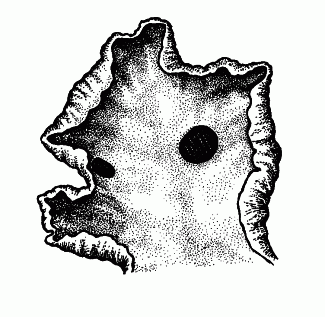Solorina crocea (L.) Ach.
Chocolate chip
Peltigeraceae
Introduction to the Lichens
Chocolate chip
Peltigeraceae
Introduction to the Lichens
Map
Distribution of Solorina crocea unavailable
Species Information
General:
Common Name: The Owl Lichens. Alludes to the typically round, large apothecia, which are usually somewhat sunken below the average level of the upper surface.
Small to medium (rarely minute) stratified foliose lichens, corticate above and below, nonsorediate, nonisidiate, bearing cephalodia, lobes closely appressed to more often loosely appressed, short to subrotund, averaging to 0.5–3 (–10) mm wide, thin. Upper surface pale greenish or occasionally orangish brown, shiny or dull. Lower surface white or, in one species, orange, dull, usually weakly veined, often bearing scattered rhizines. Medulla white (orange in one species). Photobiont green and blue-green.
Apothecia immersed in upper surface, disc reddish brown; spores 2-celled, ellipsoid, brown, 2–8 per ascus.
Over soil and mosses over soil, usually base-rich sites.
Notes: Solorina is a boreal–arctic genus consisting of about ten species worldwide. Five species are reported for North America and all occur in B.C. Spot tests are of little taxonomic value in this genus and have therefore been omitted in the species accounts. For points of distinction with similar lichens, see the descriptions under Peltigera .
Species description:
Medulla bright orange; over acid or base-rich soil in snowy localities; alpine and subalpine
Source: Lichens of British Columbia
Illustration

If more than one illustration is available for a species (e.g., separate illustrations were provided for two subspecies) then links to the separate images will be provided below. Note that individual subspecies or varietal illustrations are not always available.
Illustration By: Trevor Goward
Habitat and Range
Habitat: Frequent over acid and base-rich soil in seepage sites below late-lying snow patches at alpine and subalpine elevations throughout, except possibly absent from hypermaritime localitiesWorld Distribution: circumpolar, S to NM.
Source: Lichens of British Columbia